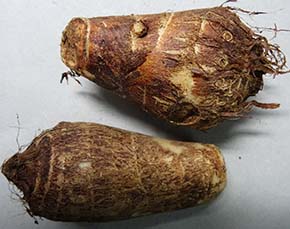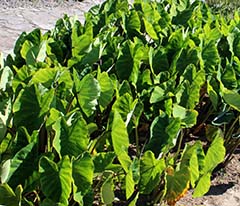Malanga Nutrition facts
Malanga or Yautia is a corm (modified stem) native to the Northern part of South America and the Caribbean. It is also recognized by the names new cocoyam, tannia, tannier, mangaras, taioba (in Portuguese), amadumbe (in South Africa), etc.
Botanically, Yautia belongs to the family of Araceae, a group of decorative plants related to the Philodendron. The corm is referred to inaccurately as tuber, root, cormel, etc. Apart from the tuber, the leaves of the yautia are also nutritious and edible.
Scientific name: Xanthosoma sagittifolium.
 |
| Malanga tubers, popular as yautia. |
The tuber is irregular in shape. It is covered with smooth skin, which depending on the cultivar type, may often be covered with fibrils or small roots. Its firm, crunchy, and slightly viscous flesh can be white, yellow, orange, pink, or reddish in color. It has a strong, slightly earthy, and vaguely nutty flavor. Malanga is highly in starch composition.
 |
| Xanthosoma sagittifolium (yautia) plant. |
Malanga is a perennial tropical plant that flourishes in well-draining fertile soil. Several large, shield-like leaves with long, erect, and ribbed petioles emerge from the stem.
The corm (root) is a modified stem, which is the storehouse of starch. Only laterally borne corms (cormels) are edible. The cormels are ready for harvesting once the leaves turn yellow and begin to dry, after about 9 to 10 months of planting.
Taro (Colocasia esculenta) is a botanically different plant with similar growth characteristics and corm development as malanga. In taro, however, both the main corm and rootlets (cormels) are being used for food.
Health benefits of Malanga
Malanga cormels carry more calories than potatoes, but almost the same as water chestnuts. 100 grams of tuber provides 98 calories. Their calorie value chiefly comes from complex carbohydrates, amylose, and amylopectin. Nonetheless, they offer a modest source of proteins, vitamins, and minerals. Together with other tropical staples like yam, cassava, potato, etc, cocoyams too ensure food security to millions in Africa, Asia and Latin Americas.
Much like other starch-rich tubers, malanga tuber does not contain gluten protein. For the same reason, it provides a subsistence source with other non-gluten cereals for people who suffer from gluten-sensitive malabsorption diseases.
Starch in yautia is composed of slow-digesting complex carbohydrates; and together with moderate amounts of dietary fiber, it helps in the gradual rise and better regulation of blood sugar levels.
Yellow-fleshed malanga and young, tender leaves have significant levels of phenolic flavonoid pigment antioxidants such as ß-carotenes, and cryptoxanthin along with vitamin-A.
It also contains good levels of some of the vital B-complex group of vitamins such as pyridoxine (18% of RDA)), folates, riboflavin, pantothenic acid, and thiamin.
Moreover, the corms provide moderate amounts of some of the essential minerals like iron (12% of RDA), zinc, magnesium, copper, iron, and manganese. Besides, the root has good amounts of potassium. Potassium is an essential component of cells and body fluids that help regulate heart rate and blood pressure.
| Principle | Nutrient Value | Percent of RDA |
|---|---|---|
| Energy | 98 Kcal | 5% |
| Carbohydrates | 23.63 g | 18% |
| Protein | 1.46 g | 2.6% |
| Total Fat | 0.40 g | 2% |
| Cholesterol | 0 mg | 0% |
| Dietary Fiber | 1.5 g | 4% |
| Vitamins | ||
| Folates | 17 µg | 4% |
| Niacin | 0.667 mg | 4% |
| Pyridoxine | 0.237 mg | 18% |
| Riboflavin | 0.040 mg | 3% |
| Thiamin | 0.097 mg | 8% |
| Vitamin A | 8 IU | <1% |
| Vitamin C | 5.2 mg | 8.6% |
| Electrolytes | ||
| Sodium | 21 mg | 1.5% |
| Potassium | 598 mg | 13% |
| Minerals | ||
| Calcium | 9 mg | 1% |
| Iron | 0.98 mg | 12% |
| Magnesium | 24 mg | 6% |
| Zinc | 0.50 mg | 4.5% |
Selection and storage
Cleaned, fresh coms of yautia (malanga) can be readily available in the markets in many parts of the southern US states where a sizeable Caribbean population is present. However, in most of the Latin American markets, tannia is seen as valued and superior to yautia because of its flavor and texture.
Buy fresh, firm, medium-size hairy corms that feel heavy for their size. Avoid those with soft spots, cracks, or featuring sprouts at the scales.
Fresh corms should be stored in cool, dark, well-ventilated places as in potatoes, yams, etc. They stay well for up to 5-6 weeks when placed in the refrigerator set at 15 ℃ and 85 % relative humidity.
In the stores, choose firm roots with no cuts, mold, or soft spots. Make a small prick with the thumbnail to check whether the flesh is juicy.
Greens of malanga are fragile. Store the leaves for several days in the fridge in a loosely closed or perforated plastic bag. Wipe it with a damp cloth before storing it.
Preparation and serving methods
To prepare, peel the corm as in other tubers and cover with water to remove sticky mucilage. Yautia is only eaten cooked. To cook, boil it for 20 minutes. Boiled tubers can be used as is, as a side dish, or pureed. Also, raw corms can first be boiled or steamed, then added to a stew or soup at the end of cooking.
Generally, malanga employed as a substitute for potato or taro in the recipes across the Caribbean. The tubers are used in moderation in the recipes, as their strong flavors overpower other foods.
Here are some serving tips:
It is grated and cooked in crepes or made into Caribbean-style fritters (accras).
It is delicious fried or with a sauce.
Boiled tuber can be mashed like potato and enjoyed with meat or vegetable stews.
Like taro, yautia are also employed in the preparations of chips, flour, cookies, flakes, etc.
In Africa, dried sices of malanga milled and its flour used to prepare fufu, porridge, pancakes, etc.
Malanga leaves are cooked in the same way as spinach or used to wrap foods that are then cooked in the oven.
Safety profile
Oxalates are bitter, acrid substances found in malanga cormels, which give an astringent and burning sensation when eaten raw. Cooking eliminates these compounds and makes them safe for consumption. Adequate intake of water is recommended to flush out any absorbed oxalates in the cooked malanga. (Medical-disclaimer).
≻≻-Also read- Taro nutrition facts and health benefits.
≻≻-Back to Vegetables from Malanga nutrition. Visit here for an impressive list of vegetables with complete illustrations of their nutrition facts and health benefits.
≻≻-Back to Home page.
Further reading: